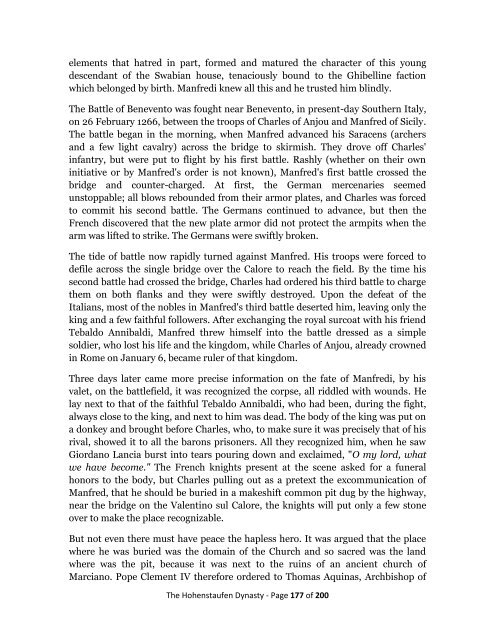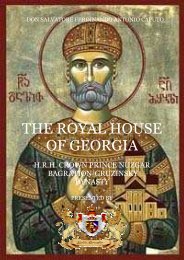here - Nobility Associations
here - Nobility Associations
here - Nobility Associations
You also want an ePaper? Increase the reach of your titles
YUMPU automatically turns print PDFs into web optimized ePapers that Google loves.
elements that hatred in part, formed and matured the character of this young<br />
descendant of the Swabian house, tenaciously bound to the Ghibelline faction<br />
which belonged by birth. Manfredi knew all this and he trusted him blindly.<br />
The Battle of Benevento was fought near Benevento, in present-day Southern Italy,<br />
on 26 February 1266, between the troops of Charles of Anjou and Manfred of Sicily.<br />
The battle began in the morning, when Manfred advanced his Saracens (archers<br />
and a few light cavalry) across the bridge to skirmish. They drove off Charles'<br />
infantry, but were put to flight by his first battle. Rashly (whether on their own<br />
initiative or by Manfred's order is not known), Manfred's first battle crossed the<br />
bridge and counter-charged. At first, the German mercenaries seemed<br />
unstoppable; all blows rebounded from their armor plates, and Charles was forced<br />
to commit his second battle. The Germans continued to advance, but then the<br />
French discovered that the new plate armor did not protect the armpits when the<br />
arm was lifted to strike. The Germans were swiftly broken.<br />
The tide of battle now rapidly turned against Manfred. His troops were forced to<br />
defile across the single bridge over the Calore to reach the field. By the time his<br />
second battle had crossed the bridge, Charles had ordered his third battle to charge<br />
them on both flanks and they were swiftly destroyed. Upon the defeat of the<br />
Italians, most of the nobles in Manfred's third battle deserted him, leaving only the<br />
king and a few faithful followers. After exchanging the royal surcoat with his friend<br />
Tebaldo Annibaldi, Manfred threw himself into the battle dressed as a simple<br />
soldier, who lost his life and the kingdom, while Charles of Anjou, already crowned<br />
in Rome on January 6, became ruler of that kingdom.<br />
Three days later came more precise information on the fate of Manfredi, by his<br />
valet, on the battlefield, it was recognized the corpse, all riddled with wounds. He<br />
lay next to that of the faithful Tebaldo Annibaldi, who had been, during the fight,<br />
always close to the king, and next to him was dead. The body of the king was put on<br />
a donkey and brought before Charles, who, to make sure it was precisely that of his<br />
rival, showed it to all the barons prisoners. All they recognized him, when he saw<br />
Giordano Lancia burst into tears pouring down and exclaimed, "O my lord, what<br />
we have become." The French knights present at the scene asked for a funeral<br />
honors to the body, but Charles pulling out as a pretext the excommunication of<br />
Manfred, that he should be buried in a makeshift common pit dug by the highway,<br />
near the bridge on the Valentino sul Calore, the knights will put only a few stone<br />
over to make the place recognizable.<br />
But not even t<strong>here</strong> must have peace the hapless hero. It was argued that the place<br />
w<strong>here</strong> he was buried was the domain of the Church and so sacred was the land<br />
w<strong>here</strong> was the pit, because it was next to the ruins of an ancient church of<br />
Marciano. Pope Clement IV t<strong>here</strong>fore ordered to Thomas Aquinas, Archbishop of<br />
The Hohenstaufen Dynasty - Page 177 of 200



